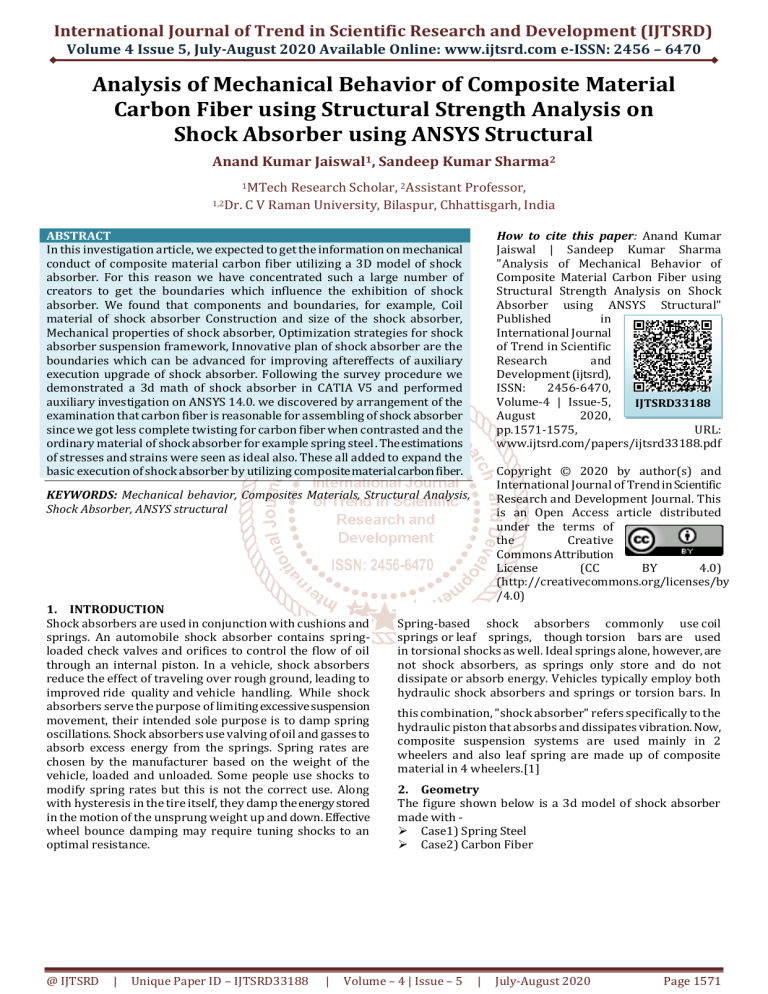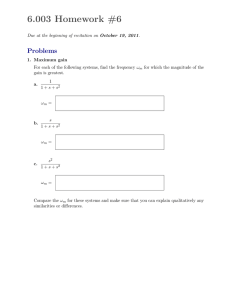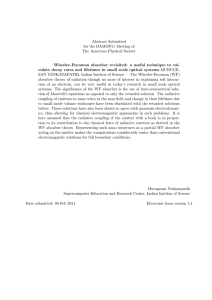
International Journal of Trend in Scientific Research and Development (IJTSRD)
Volume 4 Issue 5, July-August 2020 Available Online: www.ijtsrd.com e-ISSN: 2456 – 6470
Analysis of Mechanical Behavior of Composite Material
Carbon Fiber using Structural Strength Analysis on
Shock Absorber using ANSYS Structural
Anand Kumar Jaiswal1, Sandeep Kumar Sharma2
1MTech
Research Scholar, 2Assistant Professor,
1,2Dr. C V Raman University, Bilaspur, Chhattisgarh, India
ABSTRACT
In this investigation article, we expected to get the information on mechanical
conduct of composite material carbon fiber utilizing a 3D model of shock
absorber. For this reason we have concentrated such a large number of
creators to get the boundaries which influence the exhibition of shock
absorber. We found that components and boundaries, for example, Coil
material of shock absorber Construction and size of the shock absorber,
Mechanical properties of shock absorber, Optimization strategies for shock
absorber suspension framework, Innovative plan of shock absorber are the
boundaries which can be advanced for improving aftereffects of auxiliary
execution upgrade of shock absorber. Following the survey procedure we
demonstrated a 3d math of shock absorber in CATIA V5 and performed
auxiliary investigation on ANSYS 14.0. we discovered by arrangement of the
examination that carbon fiber is reasonable for assembling of shock absorber
since we got less complete twisting for carbon fiber when contrasted and the
ordinary material of shock absorber for example spring steel . The estimations
of stresses and strains were seen as ideal also. These all added to expand the
basic execution of shock absorber by utilizing composite material carbon fiber.
How to cite this paper: Anand Kumar
Jaiswal | Sandeep Kumar Sharma
"Analysis of Mechanical Behavior of
Composite Material Carbon Fiber using
Structural Strength Analysis on Shock
Absorber using ANSYS Structural"
Published
in
International Journal
of Trend in Scientific
Research
and
Development (ijtsrd),
ISSN:
2456-6470,
Volume-4 | Issue-5,
IJTSRD33188
August
2020,
pp.1571-1575,
URL:
www.ijtsrd.com/papers/ijtsrd33188.pdf
Copyright © 2020 by author(s) and
International Journal of Trend in Scientific
Research and Development Journal. This
is an Open Access article distributed
under the terms of
the
Creative
Commons Attribution
License
(CC
BY
4.0)
(http://creativecommons.org/licenses/by
/4.0)
KEYWORDS: Mechanical behavior, Composites Materials, Structural Analysis,
Shock Absorber, ANSYS structural
1. INTRODUCTION
Shock absorbers are used in conjunction with cushions and
springs. An automobile shock absorber contains springloaded check valves and orifices to control the flow of oil
through an internal piston. In a vehicle, shock absorbers
reduce the effect of traveling over rough ground, leading to
improved ride quality and vehicle handling. While shock
absorbers serve the purpose of limiting excessive suspension
movement, their intended sole purpose is to damp spring
oscillations. Shock absorbers use valving of oil and gasses to
absorb excess energy from the springs. Spring rates are
chosen by the manufacturer based on the weight of the
vehicle, loaded and unloaded. Some people use shocks to
modify spring rates but this is not the correct use. Along
with hysteresis in the tire itself, they damp the energy stored
in the motion of the unsprung weight up and down. Effective
wheel bounce damping may require tuning shocks to an
optimal resistance.
@ IJTSRD
|
Unique Paper ID – IJTSRD33188
|
Spring-based shock absorbers commonly use coil
springs or leaf springs, though torsion bars are used
in torsional shocks as well. Ideal springs alone, however, are
not shock absorbers, as springs only store and do not
dissipate or absorb energy. Vehicles typically employ both
hydraulic shock absorbers and springs or torsion bars. In
this combination, "shock absorber" refers specifically to the
hydraulic piston that absorbs and dissipates vibration. Now,
composite suspension systems are used mainly in 2
wheelers and also leaf spring are made up of composite
material in 4 wheelers.[1]
2. Geometry
The figure shown below is a 3d model of shock absorber
made with Case1) Spring Steel
Case2) Carbon Fiber
Volume – 4 | Issue – 5
|
July-August 2020
Page 1571
International Journal of Trend in Scientific Research and Development (IJTSRD) @ www.ijtsrd.com eISSN: 2456-6470
Fig.4.1) Fixed support at bottom end
Fig.2.1 3D Geometry of shock absorber
3. Meshing
The figure shown below shows the meshing of shock
absorber geometry made with
Case1) Spring Steel
Case2) Carbon Fiber
The figure shown below shows the application of 1200N
tensile force at the top end
Fig.3.1) Wireframe Meshing of Shock Absorber
4. Solver setup
The following figures show the setup for solution in the
Ansys 14.0.
Case1) Spring Steel
Case2) Carbon Fiber
The figure shown below shows the fixed support applied at
bottom end.
Fig.4.2) Tensile force at top end
Table 4.1) Details of Material Properties
properties→
material name↓
Spring Steel
Carbon Fibre
Density ( g/cm3)
Modulus of Elasticity (GPa)
Poisson ratio
Tensile Strength(MPa)
7.85
1.8
200
230
0.3
0.3
460
4900
Table 4.2) details of loads and supports
Object Name
Fixed Support
Force
State
Fully Defined
Scope
Scoping Method
Geometry Selection
Geometry
1 Face
@ IJTSRD
|
Unique Paper ID – IJTSRD33188
|
Volume – 4 | Issue – 5
|
July-August 2020
Page 1572
International Journal of Trend in Scientific Research and Development (IJTSRD) @ www.ijtsrd.com eISSN: 2456-6470
Type
Suppressed
Define By
Coordinate System
X Component
Y Component
Z Component
Definition
Fixed Support
Force
No
Components
Global Coordinate System
0. N (ramped)
1200 N (ramped)
0. N (ramped)
5. Results
The figures shown below are the contour graph of results of
analysis for equivalent stress (Von -Mises) and total
deformation
Case1) spring steel
Case3) Carbon fiber
Fig.5.5) Equivalent stress for Carbon Fiber
Fig.5.1) Equivalent stress for spring steel
Fig.5.6) Total Deformation for carbon fiber
Fig.5.2) Total Deformation for spring steel
@ IJTSRD
|
Unique Paper ID – IJTSRD33188
|
Volume – 4 | Issue – 5
|
July-August 2020
Page 1573
International Journal of Trend in Scientific Research and Development (IJTSRD) @ www.ijtsrd.com eISSN: 2456-6470
Table 5.1) solution results of all the materials for
equivalent stress von mises and total deformation
Name of material→
Spring
Carbon
solution↓
steel
Beryllium
fiber
Equivalent stress
6.0666
6.3783
6.0666
(MPa)
Total
0.0076474 0.0051135 0.0066499
deformation(mm)
Conclusion
The structural performance of shock absorber was analyzed
by a comparative study using conventional material of shock
absorber i.e. spring steel and materials which is namely as
beryllium and carbon fiber. The structural analysis was done
using ANSYS fluent 14.0. It is concluded that composite
materials carbon fiber and beryllium have lower value of
total deformation when compared to conventional material
of shock absorber which leads to high structural strength of
shock absorber. It is also concluded that the values of
equivalent stresses and equivalent strains are also optimum
for carbon fiber and beryllium. So the enhancement of
structural strength of shock absorber is achieved using
carbon fiber and beryllium.
REFERENCES
[1] Prince Jerome Christopher J. &Pavendhan R. “Design
and Analysis of Two Wheeler Shock Absorber Coil
Spring”, International Journal of Modern Engineering
Research, page no 133-140.
[2] VittoreCossalter, Alberto Doria, Roberto Pegoraro&
Luca Trombetta, “Testing And Modelling Of An
Advanced Motorcycle Shock Absorber”, Proceedings Of
The ASME 2010 10th Biennial Conference On
Engineering Systems Design And Analysis ESDA2010
Istanbul, Turkey july 12-14, 2010.
[3] Mr. Anirudh M. Shende, Prof. Shirish N. Gandhare& Dr.
S. P. Untawale, “Failure Analysis Of Helical Coil Spring
In Automobile System Using Finite Element Method”,
International Journal of Research In Science &
Engineering, Volume 2 Issue 5.
[4] SomnathJagtap, “The Probabilistic Design Approach To
Heical Coil Spring Using Ansys PDS”, International
Research Journal Of Multidisciplinary Studies,Vol. 2,
Special Issue 1, March, 2016.
[5] Anil Agarwal&Vaibhav Jain, “Design And Analysis Of
Helical Spring In Two Wheeler Suspension System
Using Finite Element Method”, International Research
Journal of Engineering and Technology, Volume: 04
Issue: 09 Sep -2017
[6] RutujaDeshmukh, SumantPatil & AmolKokare,
“Optimization of Shock Absorber Parameters by Using
DOE and Validation by MATLAB Software”,
International Advanced Research Journal in Science,
Engineering and Technology, Vol. 4, Issue 9, September
2017.
[7] W H Tan, J X Cheah, C K Lam, E A Lim, H G Chuahand& C
Y Khor, “Vibration analysis on compact car shock
absorber”, Journal of Physics: Conf. Series908,2017.
[8] M. Kamal and M. M. Rahman, “Finite Element-Based
Fatigue Behaviour Of Springs Inautomobile
Suspension”, International Journal of Automotive and
@ IJTSRD
|
Unique Paper ID – IJTSRD33188
|
Mechanical Engineering, Volume 10, pp. 1910-1919,
July-December 2014.
[9] Muhammad Zahir Hassan, MohdKamarulHafis Abdul
Aziz &Frank Delbressine and Matthias Rauterberg,
“Numerical Analysis of Spring Stiffness in Vehicle
Design Development Stage”, International Journal of
Applied Engineering Research, Volume 11, Number 7
(2016) pp 5163-5168.
[10] SagarNamdevKhurd, Prasad P. Kulkarni and S. D.
Katekar, “New Design Approach of Helical Coil Spring
for Longitudinal and Translational Invariance by Using
Finite Element Analysis”, Springer International
Publishing, AG 2018.
[11] FadiAlkhatib and Anoop K. Dhingra, “Dynamic Analysis
and Design of Motorcycle Mounting System Subjected
to Road Loads”, IJRE, Vol. 03 No. 08, August 2016.
[12] Dr. Dhananjay. R. Dolas, Kuldeep. K. Jagtap, “Analysis of
Coil Spring Used in Shock Absorber using CAE”,
International Journal of Engineering Research, Volume
No.5, Issue No.2, pp: 123- 126.
[13] Vijay Barethiye, G. Pohit & A. Mitra, “A combined
nonlinear and hysteresis model of shock absorber for
quarter car simulation on the basis of experimental
data”, Engineering Science and Technology, an
International Journal, (2017).
[14] P. Mohan, K. V. Poornachandran, P. Pravinkumar, M.
Magudeswaran & M. Mohanraj, “Analysis of Vehicle
Suspension System Subjected to forced Vibration using
MATLAB/Simulink”, IJIRST, National Conference on
Recent Advancements in Mechanical Engineering
(RAME’17) March 2017.
[15] S. Gopinath, R. J. Golden Renjith & J. Dineshkumar,
“Design and Fabrication of Magnetic Shochk Absorber’,
International Journal of Engineering and Technology, 3
(2), 208-211, 2014.
[16] P. N. L. Pavani, B. K. Prafulla, R. PolaRao & S. Srikiran,
“Design, Modeling and Structural Analysis of Wave
Springs”, 3rd International Conference on Materials
Processing and Characterisation, ICMPC ,2014.
[17] Ashish M. Choube, Ravikant V. Paropate, Manish S.
Hajare, Sagar P. Lakhani, Sujit P. Khairkar&Shanu S.
Indurkar, “ Stress Analysis Of Mono Suspension
Spring”, International Journal Of Innovative Technology
And Research Volume No.2, Issue No. 2, February –
March 2014, 785 - 787.
[18] Asst. Prof. N. Vivekanandan, AbhilashGunaki,
ChinmayaAcharya, Savio Gilbert And RushikeshBodake,
“Design, Analysis And Simulation of Double Wishbone
Suspension System”, IPASJ International Journal of
Mechanical Engineering, Volume 2, Issue 6, June 2014.
[19] MarnishModi, Krishna Dave & DipenModi, “Review
Paper Of Design And Analysis Of Two Wheeler Vehicles
Rear Shock Absorber”, International Journal For
Research In Applied Science & Engineering Technology
(IJRASET), Volume 2 Issue Xi, November 2014.
[20] Vishal Chaudhari and Prof. G. V. R. S. Rao, “Structural
Analysis of Helical Compression Spring”, IJSRSET,
Volume 2 Issue 4 2016.
Volume – 4 | Issue – 5
|
July-August 2020
Page 1574
International Journal of Trend in Scientific Research and Development (IJTSRD) @ www.ijtsrd.com eISSN: 2456-6470
[21] ShidaNie, Ye Zhuang, Yong Wang &KonghuiGuo.
“Velocity & displacement-dependent damper: A novel
passive shock absorber inspired by the semi-active
control”, Mechanical Systems and Signal Processing 99
730–746, 2018.
[22] Ragupathi. P, Dhayanidhi. E, Arunachalam. S,
Jegadeshwaran A & Kamal Hassan. P, “Design of Helical
Spring
Suspension”,
Imperial
Journal
of
Interdisciplinary Research (IJIR) Vol-3, Issue-4, 2017.
[23] Manoj A. Kumbhalkar, Dr. D. V. Bhope& Dr. A. V.
Vanalkar, “Material and Stress Analysis of Railroad
Vehicle Suspension: AFailure Investigation”, Procedia
Materials Science, 10 331 – 343, 2015.
[24] Dr. A. Gopichand, Ch. Harish Kumar, B. Mahesh Krishna
& D. BhanuPrakash, “Static Structural and Fatigue
Analysis of Two Wheeler Shock Absorber”,
International Journal of Emerging Trends in Science and
Technology, Vol 01, Issue 10, Pages 1627-1633,
December, 2014.
[25] G. R. Chavhan, S. W. Burande & Dr. L. P. Dhole, “Analysis
Of Shock Absorber Using Different Material Of Spring”,
International Journal Of Advanced Engineering
Technology, Vol. V/Issue Iv/Oct.-Dec.,2014.
[26] MarnishModi, SalehaShaikh & Prof. A. N. Shayani,
“Design and analysis of two wheeler vehicles rear
shock absorber by using composite E glass Epoxy
@ IJTSRD
|
Unique Paper ID – IJTSRD33188
|
material”, International Journal Of Engineering
Innovation And Scientific Research,Vol.1 (1)-P.P-01-06,
2016.
[27] Suraj R. Bhosle, Shubham R. Ugle& Dr. Dhananjay R.
Dolas, “Comparative Analysis of Suspension System
Coil Spring Using FEA”, Imperial Journal of
Interdisciplinary Research (IJIR), Vol-3, Issue-1, 2017.
[28] H. Deng, Haiping Du, Weihua Li &GurselAlici, “A
Compact Variable Stiffness and Damping Shock
Absorber for Vehicle Suspension”, IEEE/ASME
Transactions on Mechatronics, 2015.
[29] Rahul Tekade&ChinmayPatil, “Structural and Modal
Analysis of Shock Absorber Of Vehicle”, International
Journal Of Engineering Trends And Technology (IJETT) –
Volume 21 Number 4 – March 2015.
[30] Ch. Ramakrishna, N. Sivateja, S. Rajashekar and P.
BhaskarRao, “Typical Experimental Design & Testing of
Model MR Damper using Helical coiled spring”,
International Journal of Current Engineering and
Technology, Vol.7, No.2, April ,2017.
[31] Frederick T. Wallenberger; Paul A. Bingham (October
2009). Fiberglass and Glass Technology: EnergyFriendly Compositions and Applications. Springer.
pp. 211–. ISBN 978-1-4419-0735-6.
Retrieved 29
April 2011.
Volume – 4 | Issue – 5
|
July-August 2020
Page 1575




